Being an assessment of all the strips that originated in/for the Judge Dredd Megazine. You know, the comic that started in 1990 and is somehow still going to this day, closing in on 500 issues, despite numerous brushes with death. It’s worth unpicking the history of this publication a little bit, because it has a weird and complicated history…
Vol. 1: 20 issues. Monthly, from Oct 1990 to May 1992. 48 pages.
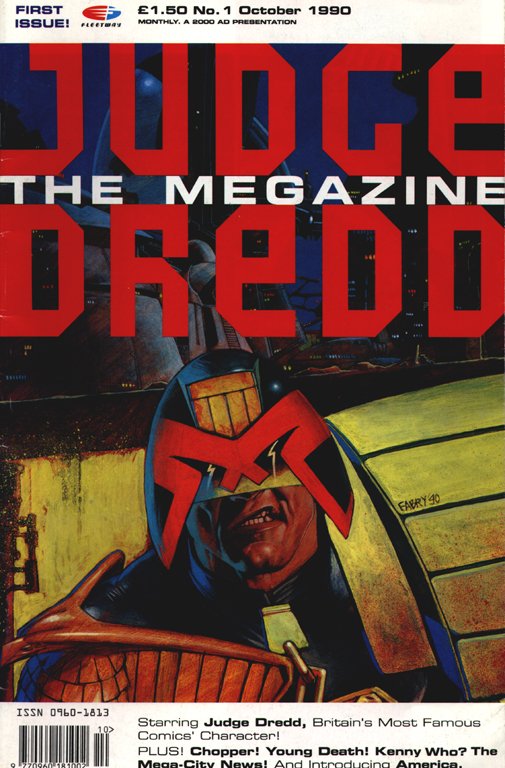 |
| Art by Glenn Fabry |
-the first 12 or so issues are still, probably, the best incarnation of the mighty Megazine. They feature (almost entirely) all-new strip every single issue, as produced by a mixture of very capable old hands (John Wagner, Alan Grant, Colin MacNeil, Carlos Ezquerra, Jim Baikie, Can Kennedy) alongside new and exciting (but with some experience) young hands (e.g. Garth Ennis, Mark Millar, Sean Phillips, Dean Ormston).
It was masterminded by long-serving 2000AD editor Steve MacManus, with input from another young, keen pair of hands with very little prior comics experience… David Bishop, sub-editor soon to become full editor.
Worth noting that the first few issues included a feature titled Mega City
News* which is mostly text-based, (text-only pages would become a big part
of the Meg in future)
Also worth noting that already in volume 1 we get Heavy Metal Dredd,
which starts the trend of the Meg reprinting 2000AD-related comics that first
saw publication in non-2000AD media.
On a more personal note, this comic looms large in my own
comics-reading youth. I was 12 when issue 1 came out, and vividly remember
buying it at a service station where we stopped the coach on a school trip to
France. I’d just lately become a total 2000AD fanatic, reading my big brother’s
Prog every week (and let me tell you, getting a weekly dose of Necropolis was
just the most exciting thing ever). I hadn’t especially intended to buy the
Megazine, despite the many ads for it in the prog, thinking it would be very
much for grown-ups. I was the kind of kid who loved the idea of watching
18-rated horror films but was far to scared to try. I assumed the Megazine
would similarly be too old for my tastes.
I was right.
I mean, I kinda liked it, especially Young Death, but
Chopper had weird rude jokes in that I didn’t quite understand, and America had
naked bottoms in it, in the context of two people who’d clearly just had sex. I
did not understand anything going on in Midnite’s Children, despite the
gorgeous artwork. I did not buy the next issue, but instead followed on with
some envy as trailers for each new story appeared in the weekly Prog (Armitage
looked especially enticing, although back then I even thought Inspector Morse
was too ‘adult’ so was doubly put off actually reading it).
As if that wasn’t enough, I have equally vivid memories of
going to Mega City Comics in Camden to buy my Marvel fix for the week, and
clocking the poster-version of the cover of issue 14 – by Simon Bisley – and
feeling properly queasy. As always, 2000AD predicted the future way ahead of
time; in this case the mid-2000s horror movie trend for torture porn and
dirty-green-bathroom aesthetics.
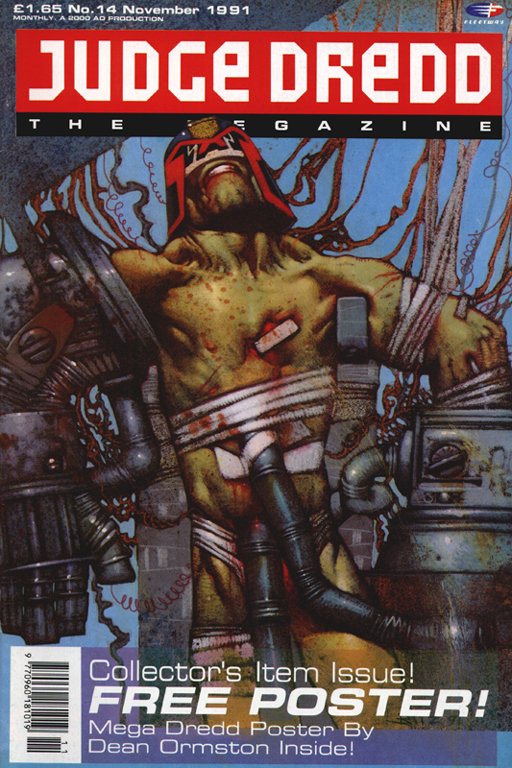 |
| Thanks for all the waking nightmares, Simon Bisley... |
So anyway, perhaps for this very specific reason, I’ve always had the belief that the Judge Dredd Megazine (aka Judge Dredd: the Megazine) was always meant to be, and still is, a comic that follows Judge Dredd and his world but aimed very much at grown up readers. With a focus on sex and violence and noirish stories that end with people losing battles and generally feeling grumpy. I was not moved to actually buy new issues until…
Vol. 2: 83 issues. Fortnightly from 2 May 1992 to 7 Jul 1995. 36? pages
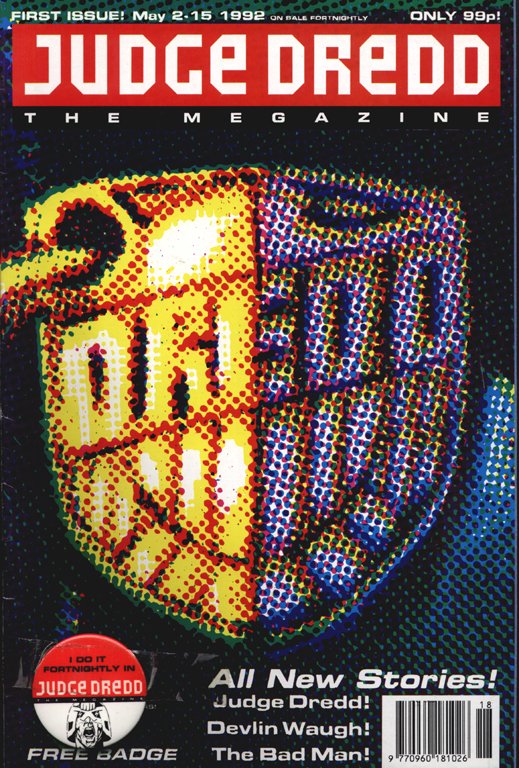 |
| Cover art credited to Sean Phillips. Is this really the way to launch a 'new' comic? |
-this version is, to be fair to editor David Bishop who was very much in charge by this point, basically more of the same as Volume 1, only twice as often and with slightly fewer pages. So a MUCH greater need to burn through both excellent comics (by John Wagner and Alan Grant, often involving Carlos Ezquerra and Colin MacNeil) and terrible comics, as produced by a roster of increasingly newer, still exciting, but often very inexperienced creators.
Worth noting that Volume 2 has very little reprint at all. Even Heavy Metal
Dredd moves from reprinting strips to running all-new material under the same
banner.
The text features continue, in the form of extended reader letters/shouty
debate form, and some frequent ‘reviews of the year / rundowns of people’s
preferred stories’ features. I miss those!
So anyway, when Volume 2 was trailed in the Prog in early
1992, it became an immediate must buy, and I persuaded my parents to add it to
the weekly newspaper-and-Prog delivery list. Why? Because of Armageddon: the
Bad Man, which promised to be a) drawn by Carlos Ezquerra and b) to tell the
as-yet untold secret history of how freedom-loving USA became
fascist-Judge-ruled Mega City 1. And, also, because there was going to be a
cross-over with the upcoming Judge Dredd epic Judgement Day. (And I was just
going to have to cope with the presence of the Sean Phillips-painted Devlin
Waugh, which was definitely going to be one of those nasty gorey sexy comics
aimed at the 18+ crowd, and not OK for a sensitive now 14-year old).
So it turned out that Armageddon went nowhere
(although I held onto hope for a second series for most of Volume 2’s tenure). The
Megazine episodes of Judgement Day were kind of bad. (I’ve never tried
reading that epic without reading those episodes, though – I’ve no idea if it
works fine without them?) Devlin Waugh, of course, is rather excellent,
although it WAS a bit more grown-up in tone that I was ready for at the time.
 |
| My first exposure to fisting words by John Smith. Art by Sean Phillips |
Volume 2 continued the trend of a) being edited by David Bishop, and b) picking up new series set around the world of Dredd, being generally more grown up, but also, sadly, continued the trend of late-period volume 1 by being basically not as good as the first handful of issues. You, you know, there was typically one truly excellent story, one or two very good ones, and then a few that were either too experimental for my young brain, too confusingly told, or just plain bad.
One of the more confounding (if understandable) decisions made with Volume 2 was to give each strip an intro page. On the one hand, it allowed for generous 'what is this story about' and 'previously on' pages of text, which for some strips turned out to be ESSENTIAL to have a hope in hell of working out what is going on. On the other hand, it seemed to coincide with a change in British comics style, whereby the writers just did not want to give any of that info in the strips themselves. But most damning of all, strips lost their logos. Now, I get that designing logos is neither easy nor, likely, cheap to do well. And I get that it's nice to let pages of art breathe. But I'm very much of the mind that part of the joy of a comic IS the logo, whether it's on the cover of a US-style self-contained comic or, better yet, on the first page of a British anthology hit. Still, can't fault the experiment or the pagecount/time-saving logic, just sad it ran for so long!
Of course, as bad as Volume 2 could be in places (and boy did the letter writers love to make that opinion VERY clear), it wouldn’t reach the lows of…
Vol. 3: 79 issues. Fortnightly from 21 Jul 1995 to 5 Jan 1996 (#1 – #13), monthly from Feb 1996 to Jul 2001 (#14 – # 79). Bumps back up to 48 pages
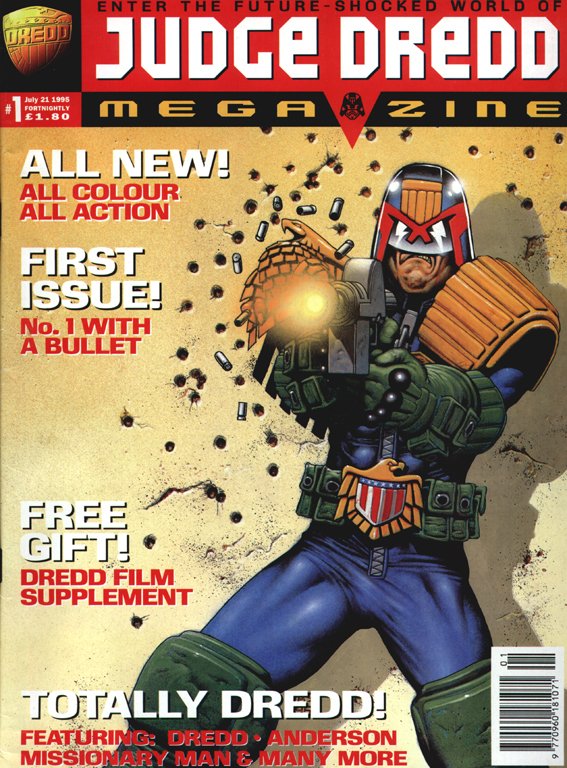 |
| Art by Jason Brashill |
-this was the beginning of the end (except not) for the Megazine. It relaunched
with a new No. 1 in July 1995 because OF COURSE hundreds thousands tens of
thousands of new readers were going to wander into WHSmiths to buy a Judge
Dredd comic after basking in the glory of the Judge Dredd film. Which would in
turn justify the continuation of a fortnightly comic with all-new stories, even
though the last year or so of volume 2 has reached something of a creative
nadir of mainstream British comics, and one assumes dwindling sales to match.
This did not happen. Even worse, although the stories in the
first 30 or so issues of Volume 3 are fine, there were no high highs to match
the best of Volumes 1 and 2. This may or may not have coincided with a drop in
reader numbers. Anyway, in order to save the comic, the editors (a juggling
combo of Bish-Op and John Tomlinson taking turns at various points) chose
a) to run America II - which certainly kept me reading, even
as I remember vaguely thinking it was time to call it quits… b) run a new
crossover story, Predator vs Judge Dredd (another hook to keep the likes of me
interested)…
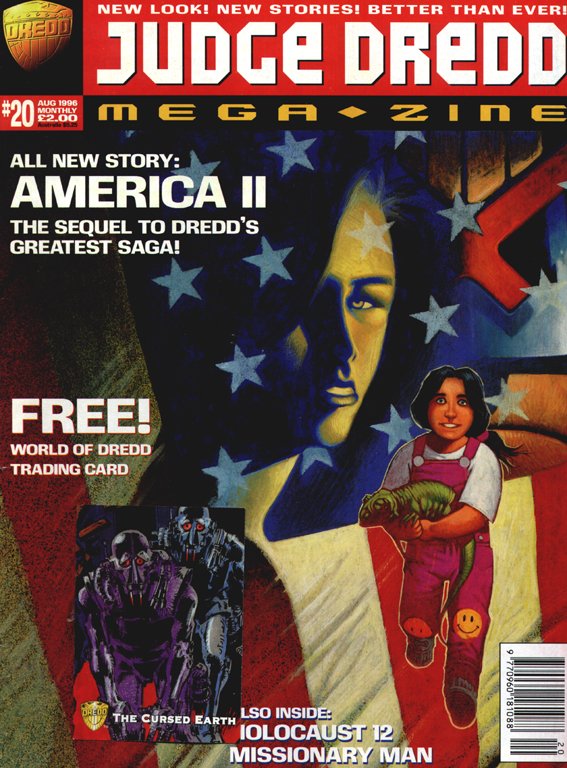 |
| Art by Colin McNeil |
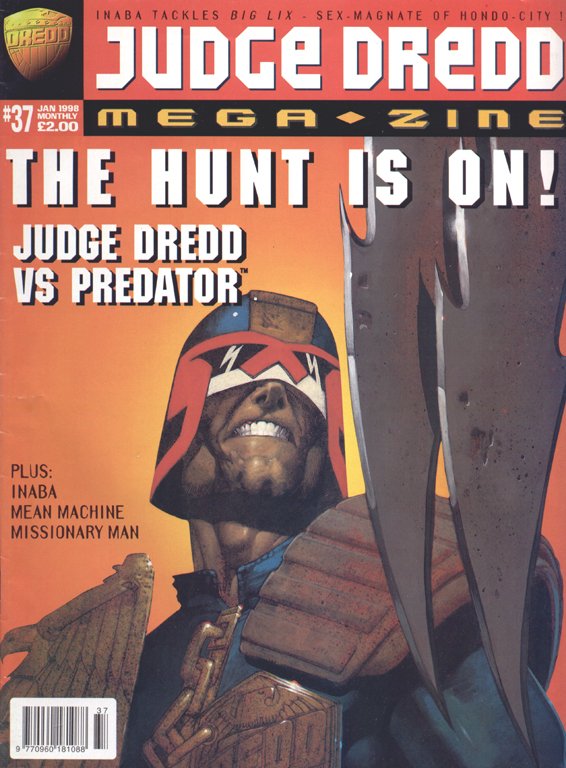 |
| Art by Greg Staples |
And then very swiftly b) to combine just ONE (usually very
good John Wagner scripted) new Judge Dredd story alongside some hefty reprints
of trendy comics. I cannot stress enough how well this worked! The comic kept
on being published! Readers kept on buying!
From a personal point of view, it’s very much worth saying
that I, a loyal Megazine reader but not someone who read the editorials or intro bits, did not even notice that anything was weird. I genuinely thought the
Meg was running a new strip by Garth Ennis and Steve Dillon called Preacher that felt a bit
less Dreddworld than most but kinda not completely out of keeping with the
general tenor of the Megazine? And it was bloody marvellous, too!
(I was at least aware when they started running Sin City and
Hellboy that these were pre-existing non-2000AD comics, but as I’d not read
either before was glad to have the opportunity here).
By the time Volume 3 was getting to the end, Andy Diggle had
joined as assistant editor, and pushed for the reprint slot to be taken up old
2000AD strips (no doubt even cheaper to run). And there were, at last, new
stories – once again, by new and exciting creators (including the likes of
Michael Gaydos and Jock). This small burst of editorial creativity was enough
to herald a new dawn…
Vol. 4: 18 issues. Monthly from Aug 2001 to Mar 2002
(#1 – #8), every four weeks from 2 Apr 2002 to 17 Dec 2002 (#9 – #18). 100
pages!
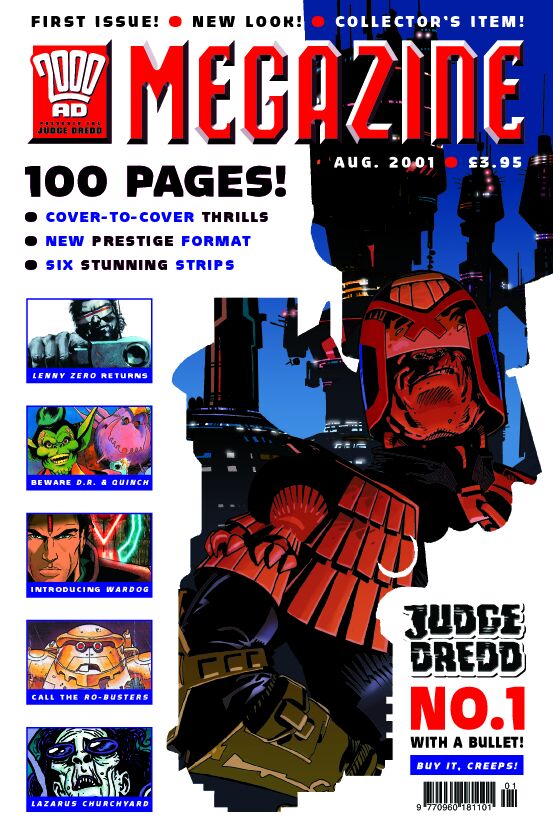 |
| The main picture is by Colin Wilson |
So this was a huge breath of fresh air, a big change-up from what had gone before. Am guessing, the brainchild of David Bishop and Andy Diggle, with a huge helping of permission from new publisher/owner Rebellion? Basically, it felt like a re-think of the whole project as a big, fat magazine. It had a mix of new comics, reprints of British comics, and text articles. The one downside – and I realise this is a me problem – it felt less collectible as a comic. Like, there were new stories in there that followed what had gone before in the Megazine (especially Judge Dredd), but it was very much bundled up with other things that were disposable. (Not in a bad way, just in a ‘magazines are designed to be read then discarded’ kind of way.)
 |
| Long-form articles about the history of comics! More please. (This one's by Ed Berridge) |
Worth mentioning, just about, that this volume saw the first instance in the Meg of a series commissioned to tie in with a video game created by Rebellion (and never mind if said game(s) ever actually came out or not).
And definitely worth mentioning that one of the new
text strands focussed on comic history, beginning with a feature that became,
for me, THE must-read bit of the Megazine during this period.**
The whole thing was a big success, and with renewed faith in
the Megazine as a going concern, it was decided to just stop mucking about
with ‘volumes’ and just turn it into the comic it was originally intended to
be…
Vol. 5: ongoing. Numbering reset to #201 (200 issues
had been published prior to this). Every four weeks from 14 Jan 2003 to 11 Sep
2012 (#201 – #327), then monthly from 18 Oct 2012 (#328) to present.
 |
| Art by Cliff Robinson |
Honestly, it’s as if someone (incoming editor Alan Barnes) was listening to my complaint about volume 4 – the big change here is that a large part of the chunky reprint section was stapled together inside its own mini-magazine that you could (and I did!) literally prise out of the pages of the main magazine. In time, this would end up being issued as an entirely separate bundle (unlovingly called a ‘floppy’ or ‘bagged mini-trade’).
Although the numbering and overall format has largely stayed the same within volume 5, there have been a number of phases, to do with the types of text features and reprints, if not the basic comics. It’s hard to quantify, but compared to the glory (?) days of Volume 2, there’s a little less emphasis on giving new, untried creators the chance to run with some wild idea, before maybe they get a shot at 2000AD. It’s more like both comics need a constant churn of new and existing creators, and the Megazine just gives them more pages to play with. The fact is, something is working - the Meg keeps hitting milestone after milestone, and seems on course to reach issue 500.
 |
| Art by Glenn Fabry |
 |
| Art by Greg Staples |
Anyway, some micro-phases with the modern Megazine:
There was the ‘small press’ slot, in which British indie comics were given a
space, and a platform to reach a far wider audience than a typical comics
convention. These were, mostly, not very good (sorry, indie creators!) – but
some of those creators DID go on to a) get a lot better and b) work on stories
for the Megazine in future. Shades of Volume 2, then, by stealth.
Then came the 'Creator-owned' slot. This was a mix of the Megazine co-publishing new comics - by 2000AD creators - alongside or perhaps even before they were released by other publishers such as Image? This started with a BIG name: Tank Girl. I’m not always clear if these only appeared – in the UK at least – in the Megazine, or if they might never have come about had the Meg had not said up front they’d pay for the rights to print them? Anyway, these creator-owned comics were often tangential at best to the core idea of a comic about Judge-Dredd-related stuff. On the other hand, they were a useful place to show off to the world what British comics creators could do in the space of ‘comics intended for grown ups’! Something about the way they were presented was almost like 'here are some comics that are arguably too good for the Meg to have commissioned as original work'. But in fact, the truth was more 'these are (mostly) good comics that the creators wish to retain ownership of!' I have no idea if the experiment either cost the Meg more to print than they would like, or helped put more money than usual into the pockets of the creative teams.
This gave way to reprints of stories about 2000AD characters
that were originally made for the US market, by a mix of Brit and non-Brit
creators. These are a real mixed bag. But, they definitely ‘fit’ into the
Megazine concept.
Alongside these were and still are reprints of classic
British comics. It’s where I first read Darkie’s Mob and Charley’s War, for
example. More recently they function more like teasers for reprint collections
of the less beloved (but often still good) Treasury of British Comics stuff.
Meanwhile, the text articles at first included long-form
essay-type material examining the history of comics, or film subgenres, and
things like that. Disposable but often very good. There were regular review
sections for new films, new comics, including Manga, and similar. There was
Gordon Rennie moaning in amusing fashion. And there were interviews with any
and all creators who ever worked in 2000AD or the Megazine – the one feature
that has lasted all the way through to today.
For a while, there was a stealth attempt to get a sort of Megazine mascot editor, but it was never more than a header image - wonder why it didn't catch on?
 |
| Portrait of the editor as a Young Security Camera. Art (uncredited but I'm pretty sure), by Pye Parr |
Just recently, the Meg has been rather stealthily publishing a lot more pin-up/Star Scan pages. These are very welcome.
I have to imagine that in a super ideal world, the Judge Dredd Megazine would become ‘just’ an anthology comic featuring longer and more grown-up-in-tone stories than 2000AD, with a Dreddworld bent (but maybe not JUST Dreddworld). If the reprints/interviews/advertorials are what it takes to keep the Meg profitable, then so be it.
*If I were including Mega City News in the ranking
(I’m not -it’s almost all text and as such disqualified) it would likely get
the very lowest placement possible. It is painfully dated and when I can make
sense of it, not nearly as funny as it thinks it is…
**If I were including Thrill-Power Overload in the
ranking, it would likely get the very highest possible placement. This original
version is kinda scrappy and a little self-indulgent but I love it so much –
it’s like a podcast before podcasts existed, where professionals were pouring
their heart into producing niche content that a certain audience would just adore.
So, what IS included in this ranking? Well, the aim is to capture all those comic stories that have run
exclusively in the various incarnations of The Judge Dredd Megazine. Some
thrills that’s easier – your Armitages, your Shimuras and so on. But there are
plenty of edge cases.
Some things definitely don’t qualify:
· Strips that started in 2000AD and had the odd
go around in the magazine (e.g. Low Life, Sinister Dexter, some of the Regened strips)
Strips that appeared first in other comics, and
were reprinted in the Megazine (e.g. Lazarus Churchyard, Preacher) – including reprints
of Daily Star / Metro Dredd.
Straight up 2000AD reprints (anything in a
bagged floppy!).
The ‘Small Press’ slot.
Text stories / features / Articles (dammit, this
is a ranking of comics!)
Some things that cross lines but DO, I think, count:
· Strips that started in the Megazine but had a few goes in 2000AD (Devlin Waugh, Missionary Man) Characters who first appeared in the Prog (within the pages of Judge Dredd), but then had solo series in the Megazine (The Taxidermist, Johnny Woo)
Some things where I haven’t made up my mind yet:
· Strips that did not start in the Megazine or
2000AD, but did have all-new strips commissioned to run in the Meg (e.g. Tank
Girl, The Bogie Man and other creator-owned bits)
Strips that ran under their own banner, but only
for one episode, that may as well be considered one off ‘Tales from the
world of Dredd’ (e.g. Wynter, Repo-Mex)
Judge Dredd itself. I mean, on the one
hand it’s the only strip that has been in every issue of the Megazine. On the
other hand, how do you rank 350 Dredd stories? Some have been the best things
in the comic, others among the worst. On balance, I think better to just leave
them all to one side.
And, there are various strips that I’m not elaborating on for the sake of seeding some surprises to the ranking…
Don’t expect insightful observations about each story.
Do expect rush judgements on the quality of the story and art…
Further musings on the Megazine
A neat and informative rundown of the first two (and a bit) volumes, courtesy of 2000AD's champion stats collator, Funt Solo
A full index of stories (up to the end of 2023, anyway)
And of course, some words from the man himself, Mr David Bishop



No comments:
Post a Comment